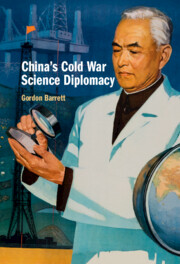Refine search
Actions for selected content:
13588 results in History of science and technology
4 - Veterinary Institutions and Animal Plagues, 1800–1900
-
- Book:
- A Concise History of Veterinary Medicine
- Published online:
- 11 August 2022
- Print publication:
- 25 August 2022, pp 134-201
-
- Chapter
- Export citation
Illustrations
-
- Book:
- A Concise History of Veterinary Medicine
- Published online:
- 11 August 2022
- Print publication:
- 25 August 2022, pp vi-xi
-
- Chapter
- Export citation

China's Cold War Science Diplomacy
-
- Published online:
- 18 August 2022
- Print publication:
- 25 August 2022
Table of Contents
-
- Book:
- Writing Gaia: The Scientific Correspondence of James Lovelock and Lynn Margulis
- Published online:
- 28 July 2022
- Print publication:
- 18 August 2022, pp ix-xii
-
- Chapter
- Export citation
Part IV - 1992–2007
-
- Book:
- Writing Gaia: The Scientific Correspondence of James Lovelock and Lynn Margulis
- Published online:
- 28 July 2022
- Print publication:
- 18 August 2022, pp 303-388
-
- Chapter
- Export citation
1984
- from Part III - 1980–1991
-
- Book:
- Writing Gaia: The Scientific Correspondence of James Lovelock and Lynn Margulis
- Published online:
- 28 July 2022
- Print publication:
- 18 August 2022, pp 239-249
-
- Chapter
- Export citation
1996
- from Part IV - 1992–2007
-
- Book:
- Writing Gaia: The Scientific Correspondence of James Lovelock and Lynn Margulis
- Published online:
- 28 July 2022
- Print publication:
- 18 August 2022, pp 350-354
-
- Chapter
- Export citation
Contributors
-
- Book:
- Writing Gaia: The Scientific Correspondence of James Lovelock and Lynn Margulis
- Published online:
- 28 July 2022
- Print publication:
- 18 August 2022, pp xiv-xiv
-
- Chapter
- Export citation
Tangled Up in Gaia
- from Part V - Commentaries on Lovelock and Margulis
-
-
- Book:
- Writing Gaia: The Scientific Correspondence of James Lovelock and Lynn Margulis
- Published online:
- 28 July 2022
- Print publication:
- 18 August 2022, pp 424-427
-
- Chapter
- Export citation
Part III - 1980–1991
-
- Book:
- Writing Gaia: The Scientific Correspondence of James Lovelock and Lynn Margulis
- Published online:
- 28 July 2022
- Print publication:
- 18 August 2022, pp 189-302
-
- Chapter
- Export citation
2002
- from Part IV - 1992–2007
-
- Book:
- Writing Gaia: The Scientific Correspondence of James Lovelock and Lynn Margulis
- Published online:
- 28 July 2022
- Print publication:
- 18 August 2022, pp 371-374
-
- Chapter
- Export citation
1998
- from Part IV - 1992–2007
-
- Book:
- Writing Gaia: The Scientific Correspondence of James Lovelock and Lynn Margulis
- Published online:
- 28 July 2022
- Print publication:
- 18 August 2022, pp 356-358
-
- Chapter
- Export citation
1999
- from Part IV - 1992–2007
-
- Book:
- Writing Gaia: The Scientific Correspondence of James Lovelock and Lynn Margulis
- Published online:
- 28 July 2022
- Print publication:
- 18 August 2022, pp 359-365
-
- Chapter
- Export citation
1988
- from Part III - 1980–1991
-
- Book:
- Writing Gaia: The Scientific Correspondence of James Lovelock and Lynn Margulis
- Published online:
- 28 July 2022
- Print publication:
- 18 August 2022, pp 272-277
-
- Chapter
- Export citation
1986
- from Part III - 1980–1991
-
- Book:
- Writing Gaia: The Scientific Correspondence of James Lovelock and Lynn Margulis
- Published online:
- 28 July 2022
- Print publication:
- 18 August 2022, pp 258-267
-
- Chapter
- Export citation
Epigraph
-
- Book:
- Writing Gaia: The Scientific Correspondence of James Lovelock and Lynn Margulis
- Published online:
- 28 July 2022
- Print publication:
- 18 August 2022, pp vii-viii
-
- Chapter
- Export citation
1983
- from Part III - 1980–1991
-
- Book:
- Writing Gaia: The Scientific Correspondence of James Lovelock and Lynn Margulis
- Published online:
- 28 July 2022
- Print publication:
- 18 August 2022, pp 224-238
-
- Chapter
- Export citation
1989
- from Part III - 1980–1991
-
- Book:
- Writing Gaia: The Scientific Correspondence of James Lovelock and Lynn Margulis
- Published online:
- 28 July 2022
- Print publication:
- 18 August 2022, pp 278-286
-
- Chapter
- Export citation
Part II - 1973–1979
-
- Book:
- Writing Gaia: The Scientific Correspondence of James Lovelock and Lynn Margulis
- Published online:
- 28 July 2022
- Print publication:
- 18 August 2022, pp 95-188
-
- Chapter
- Export citation
1982
- from Part III - 1980–1991
-
- Book:
- Writing Gaia: The Scientific Correspondence of James Lovelock and Lynn Margulis
- Published online:
- 28 July 2022
- Print publication:
- 18 August 2022, pp 208-223
-
- Chapter
- Export citation
